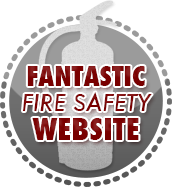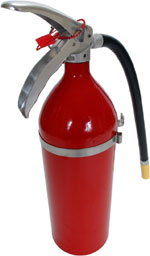Fire Extinguisher : 101
| Home |
| About Fire Extinguishers |
| Using a Fire Extinguisher |
| Fire Prevention |
| Fire Hazards |
| First Aid for Fire |
| Financial Protection |
| Biggest Fires in History |
| Firefighters |
This site was voted:

by onlinefiresciencedegree.org
(scroll to 74 on the list)
This page is intended to provide individuals with general information pertaining to the different types of fire extinguishing agents used to fight fires. |
When selecting the appropriate type of fire extinguisher, it is important to think about extinguishing agents. Each class of fire is best fought by a specific extinguishing agent. You will find a color-coded box on your fire extinguisher identifying which classes of fire it can be used for, and the type of fire extinguishing agent it contains.
The following is a list of commonly used fire extinguishing systems and their corresponding classes of fire. The classes are indicated in parentheses such as (A, B, C):
 Multi-Purpose
Dry Chemical (A, B, C)
Multi-Purpose
Dry Chemical (A, B, C)
A dry chemical agent called mono ammonium phosphate. The chemical is non-conductive
and can be mildly corrosive if moisture is present. In order to avoid
corrosion, it is necessary to scrub and thoroughly cleanup the contacted
area once the fire is out. A dry chemical fire extinguisher is usually
used in schools, general offices, hospitals, homes, etc.
Regular Dry Chemical
(B, C)
A dry chemical agent called sodium bicarbonate. It is non-toxic, non-conductive
and non-corrosive. It is easy to cleanup, requiring only vacuuming, sweeping
or flushing with water. Extinguishers with sodium bicarbonate are usually
used in residential kitchens, laboratories, garages, etc.
Carbon Dioxide
(B, C)
Carbon dioxide removes oxygen to stop a fire but has limited range. It
is environmentally friendly and leaves no residue, so cleanup is unnecessary.
Extinguishers with carbon dioxide are usually used in contamination-sensitive
places such as computer rooms, labs, food storage areas, processing plants,
etc.
Halotron (A, B,
C)
A vaporizing liquid that is ozone friendly and leaves no residue. Because
it requires no cleanup, fire extinguishers with halotron are ideal for
computer rooms, telecommunication areas, theaters, etc.
Foam (A, B)
Foam floats on flammable liquids to tame the fire and helps prevent reflashes.
To cleanup the affected area, it must be washed away and left to evaporate.
Fire extinguishers with foam are usually used in garages, homes, vehicles,
workshops, etc.
Purple K Dry Chemical
(B, C)
A dry chemical called potassium bicarbonate. It is non-conductive and
non-corrosive. Clean up requires vacuuming, sweeping or flushing with
water. Extinguishers with potassium bicarbonate are usually used in military
facilities, oil companies, vehicles, etc.
Water (A)
The most common agent is water; however, it cannot be used for class
B or C fires because it is conductive. Water-based fire extinguishers
are usually used in stockrooms, schools, offices, etc.
Wet Chemical
fire extinguishers (K)
The potassium acetate based agent discharges as a fine mist which forms
a soapy foam that suppresses any vapors and steam or the risk of fire
reflash as it extinguishes the fire. Class K fire extinguishers can usually
be found in commercial cooking areas such as restaurants and cafeterias.
Fuel
Source |
Class
of Fire |
Type
of Extinguisher (Extinguishing Agent) |
Ordinary
combustibles (e.g. trash, wood, paper, cloth) |
A |
Water;
chemical foam; dry chemical* |
Flammable
liquids (e.g. oils, grease, tar, gasoline, paints, thinners) |
B |
Carbon
dioxide (CO2); halon**; dry chemical; aqueous film forming foam
(AFFF) |
Electricity
(e.g. live electrical equipment) |
C |
CO2;
halon; dry chemical |
Combustible
metals (e.g. magnesium, titanium) |
D |
Dry
powder (suitable for the specific combustible metal involved) |
Combustible
Cooking (e.g. cooking oils; animal fats, vegetable fats) |
K |
Wet
chemical (Potassium acetate based) |
* Dry chemicals, CO2 and halon can be used on Class A fires, but may not be effective on their own. They need to be supplemented with water.
** Halon extinguishers are no longer made but some may still be in use. Dangerous gases are formed when halon is used to put out fires. Wear proper respiratory equipment, particularly in enclosed spaces. After use, do not allow anyone to enter the area until it has been well ventilated.